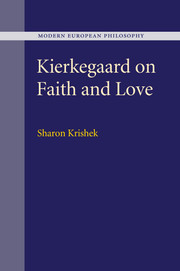4 - Neighbourly love versus romantic love
Published online by Cambridge University Press: 04 August 2010
Summary
Love and the works of love
In the second paragraph of the Preface to Works of Love Kierkegaard states the following: these ‘are Christian deliberations’, he says, ‘therefore not about love, but about works of love’ (WL, 3, emphasis in the text). This brief but emphatic declaration delineates the scope of the long discussion in the book before us: first, it is Christian in character and second (in accordance with the first point), it is about works of love and not about love. However, this should make us wonder: what is the difference between love and its works and why does Kierkegaard wish to emphasize that the latter is the business of Christianity?
One of the prominent tasks that Works of Love takes upon itself is to clarify the confusion regarding the nature of true love, as against the way the poets understand it. Kierkegaard believes that the common understanding of love – rooted in and advanced by the poets' praises of it – is a confused and misleading understanding, and that only a Christian point of view can overcome this confusion. At the same time, Kierkegaard is not interested in conducting a conceptual (or metaphysical) analysis that will fathom the mysterious essence of love, examine it from every possible angle, and conclude with a clear-cut definition of it.
- Type
- Chapter
- Information
- Kierkegaard on Faith and Love , pp. 109 - 137Publisher: Cambridge University PressPrint publication year: 2009



